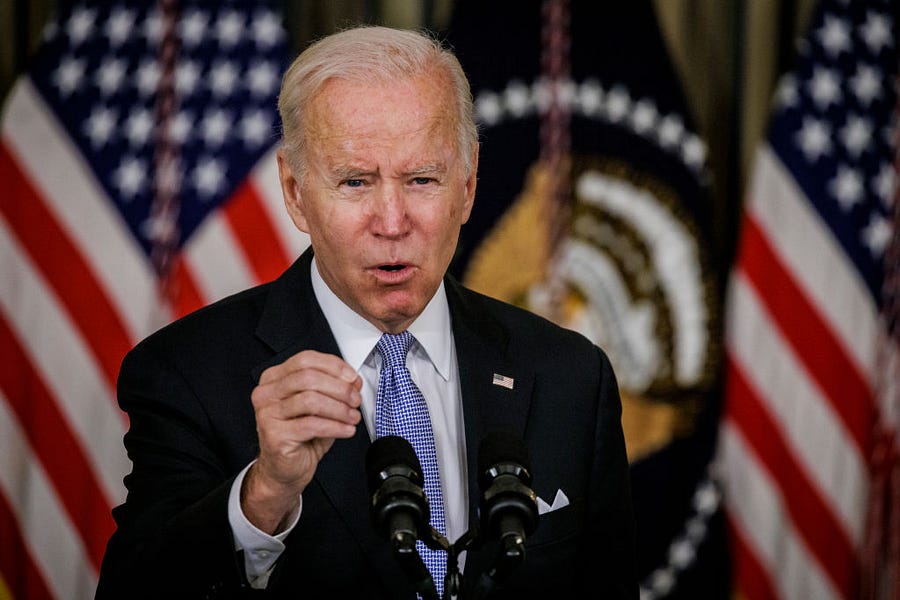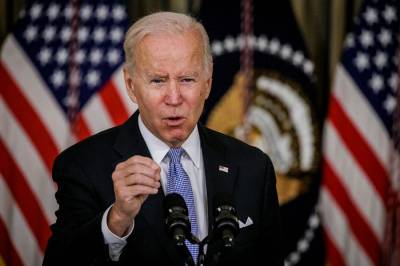No president since Andrew Johnson has escaped office without seeing his party defeated in midterms at least once. It seems nearly certain now that President Biden will be the 28th in a row to face this very public rejection—potentially a punishing one.
The swings we saw last week in the electorates of New Jersey and Virginia from state elections four years ago were tidal in volume. If they prove predictive of the size of the coming midterm shift, it would result in net gains of 30 or so seats for House Republicans. Democrats are clinging to a three-vote majority, so the members of the blue team are already feeling seasick in anticipation of another wave election. If Democrats do lose that many seats, 2022 would join the five worst midterm beatings a president’s party has taken in the modern political era—1982, 1994, 2006, 2010, and 2018.
All five of those can all rightly be understood as backlashes against the perceived radicalism of the party in power. And that is certainly the narrative Republicans are pushing for 2022. But the midterm monsoons of recent history can be better understood as expressions of frustration with the unrealized promises of the president and his party. It wasn’t the radicalism, per se, but the failure of radical ideas to produce success.
Each of the five biggest midterm losses came in the wake of radical initiatives from the sitting president. Reaganomics, Hillarycare, the invasion of Iraq, Obamacare, and Donald Trump’s governance by pathological id were all big gambles. Only one actually paid off.
Bill Clinton and Barack Obama won re-election in spite of the unpopularity of their bold moves. In Clinton’s case, he reversed course from trying to broaden the federal social safety net at the start of his first term to tightening welfare requirements as he was running for re-election, triangulating himself into an easy win. Obama, conversely, hunkered down. He would grind out a sharply negative 2012 bid and become the first president ever re-elected with fewer electoral votes than he won the first time.
George W. Bush was re-elected just as the Iraq war was taking its most calamitous turn. The month he won a second term in 2004 would become the deadliest for American troops of the entire war. After the repudiation of the 2006 midterms, Bush was a lame duck who struggled to build a consensus to respond to the financial panic of 2008.
Rather than bold plans going awry, Trump’s gamble was on having no plan at all. As he put it, “I have a gut, and my gut tells me more sometimes than anybody else’s brain can ever tell me.” As it would turn out, Trump had a serious case of indigestion. Since even the Republicans who wanted to follow him couldn’t keep up with his swerving, capricious approach, Trump’s presidency was consumed by chaos and scandal. After handing Democrats their largest midterm gains of the era, he followed his gut right out of office.
Each of these presidents was trying in his own way to replicate Ronald Reagan’s success—sometimes in very obvious ways. You can see why they would. The 40th president represented a sharp ideological shift but still managed to get elected by a wide margin in 1980 as an alternative to an untenable status quo. The backlash against unified Democratic control was so thorough, it gave Reagan long enough coattails to put Republicans in their best shape in Congress since the 1950s.
Reagan moved quickly to convert his windfall into policy results, most notably the tax cuts of 1981, which slashed the top rate by 29 percent and created new tax shelters to encourage investment. The remaining moderate Democrats and Republicans in Congress feared his clout, allowing Reagan to get the legislation through by the end of his first summer in office. But it was also at that moment that the economy fell into the second swale of a double-dip recession—the worst at that point since the Great Depression, with 90 percent of the job losses in manufacturing and construction. Voters punished Reagan and his party up and down the ballot and from coast to coast.
But as misery was piling up, the Federal Reserve was breaking the back of the inflation that had bedeviled the economy for so long. High interest rates were hard medicine, but prices came under control just as the new incentives of Reaganomics kicked in. The economy boom-boom-boomed, growing by 8 percent in 1983 and nearly 6 percent in Reagan’s re-election year of 1984—greater than anything we have seen since, until this year’s post-pandemic snapback. Reagan went on to the largest Electoral College victory in history, 525 votes, and fundamentally remade the politics of economic policy. Clinton, Bush, Obama, and Trump all aspired to replicate the pattern. And while Clinton experienced some of the political success and Obama achieved some of the policy transformation, none of Reagan’s successors have done it all.
Biden will not either. He had no coattails in his victory and therefore lacks the kinds of congressional majorities needed to push through a transformative agenda. Nor is it any kind of sure bet that Biden will be his party’s nominee in 2024, when he will be 81 years old. But we should remember that Biden and his party may still benefit from some of the boom-bust-boom cycle that Reagan did.
Amid the bad news for Democrats last week, there were some serious rays of sunshine on the issues that matter most to voters: the economy and the coronavirus: The encouraging October jobs report, the development of antiviral drugs that will effectively mean the end of the pandemic, and the passage of Biden’s long-sought infrastructure spending package.
Biden may be a fuddled messenger, but Americans certainly associate him with spending spectacular sums of money to stimulate the economy and for aggressively fighting COVID. His aggressive approach on those topics is helping Republicans right now as they focus on inflation and the authoritarian bent of the many in the public health regime. But the pandemic is ending and the economy is recovering. There’s no guarantee that will keep up—we could think of a thousand ways it wouldn’t—but it might. If it does, Democrats will get all the credit and most of the votes in 2024.







Please note that we at The Dispatch hold ourselves, our work, and our commenters to a higher standard than other places on the internet. We welcome comments that foster genuine debate or discussion—including comments critical of us or our work—but responses that include ad hominem attacks on fellow Dispatch members or are intended to stoke fear and anger may be moderated.
With your membership, you only have the ability to comment on The Morning Dispatch articles. Consider upgrading to join the conversation everywhere.